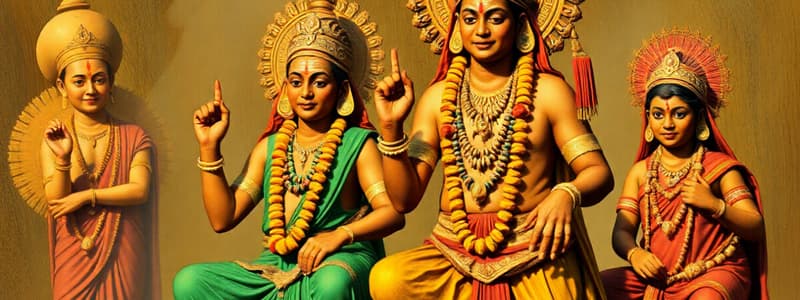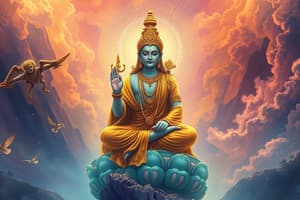Podcast
Questions and Answers
In which stage do individuals primarily pursue artha and kama?
In which stage do individuals primarily pursue artha and kama?
- Retirement Stage
- Householder Stage (correct)
- Childhood Stage
- Rejecting Life Stage
During the Retirement Stage, individuals are encouraged to engage more in worldly responsibilities.
During the Retirement Stage, individuals are encouraged to engage more in worldly responsibilities.
False (B)
What is the primary aim of samskaras performed throughout life?
What is the primary aim of samskaras performed throughout life?
To facilitate movement from one life stage to another.
The _____ stage signifies a rejection of worldly life to seek moksha.
The _____ stage signifies a rejection of worldly life to seek moksha.
Match the following stages with their characteristics:
Match the following stages with their characteristics:
Which of the following names is NOT used for Brahman?
Which of the following names is NOT used for Brahman?
Maya is a term that refers to the ultimate reality of Brahman.
Maya is a term that refers to the ultimate reality of Brahman.
What is the relationship between Brahman and the individual person?
What is the relationship between Brahman and the individual person?
Brahman is described as the ______ of all Gods.
Brahman is described as the ______ of all Gods.
What is the ultimate goal in Hinduism that signifies liberation from the cycle of rebirth?
What is the ultimate goal in Hinduism that signifies liberation from the cycle of rebirth?
Match the phrases describing Brahman with their meanings:
Match the phrases describing Brahman with their meanings:
Artha refers to the pursuit of personal wealth and greed.
Artha refers to the pursuit of personal wealth and greed.
What are the lesser goals in Hinduism where one focuses on maintaining the illusion of life?
What are the lesser goals in Hinduism where one focuses on maintaining the illusion of life?
The cycle of death and rebirth is known as ______.
The cycle of death and rebirth is known as ______.
Match the following Hindu concepts to their definitions:
Match the following Hindu concepts to their definitions:
At what age is a Thread Initiation Ceremony (Upanayana) performed for boys in the first three castes?
At what age is a Thread Initiation Ceremony (Upanayana) performed for boys in the first three castes?
The first solid food for a child is introduced at 6-8 months after birth.
The first solid food for a child is introduced at 6-8 months after birth.
What marks the transition into the Householder stage of life?
What marks the transition into the Householder stage of life?
A priest names the child ____ days after birth.
A priest names the child ____ days after birth.
Match the following milestones with their descriptions:
Match the following milestones with their descriptions:
Which path in Hinduism is most easily attainable and followed by the majority of Hindus?
Which path in Hinduism is most easily attainable and followed by the majority of Hindus?
Vishnu's avatars include Rama and Shiva.
Vishnu's avatars include Rama and Shiva.
What is the primary practice involved in Bhakti Yoga?
What is the primary practice involved in Bhakti Yoga?
The two epic poems of Hinduism that are important in Bhakti Yoga are the Ramayana and the _____.
The two epic poems of Hinduism that are important in Bhakti Yoga are the Ramayana and the _____.
Which scripture contains the Bhagavad-Gita?
Which scripture contains the Bhagavad-Gita?
Match the following paths of yoga with their descriptions:
Match the following paths of yoga with their descriptions:
Acts of worship in Bhakti Yoga can include meditation and reading scriptures.
Acts of worship in Bhakti Yoga can include meditation and reading scriptures.
Name two popular deities in Hinduism associated with Bhakti Yoga.
Name two popular deities in Hinduism associated with Bhakti Yoga.
Which of the following statements best describes the nature of Hinduism?
Which of the following statements best describes the nature of Hinduism?
Hinduism is closely associated with the history and culture of India.
Hinduism is closely associated with the history and culture of India.
What is the sacred river where Indians go to speak to the Gods?
What is the sacred river where Indians go to speak to the Gods?
The concept of the soul in Hinduism is referred to as __________.
The concept of the soul in Hinduism is referred to as __________.
Match the ancient cultures with their characteristics:
Match the ancient cultures with their characteristics:
Which scripture was created by the Aryans during the Vedic period?
Which scripture was created by the Aryans during the Vedic period?
Jainism promotes vegetarianism as part of its core beliefs.
Jainism promotes vegetarianism as part of its core beliefs.
What does the term 'Brahman' signify in Hinduism?
What does the term 'Brahman' signify in Hinduism?
Hinduism introduced __________, which is self-denial or self-harm to strengthen the soul.
Hinduism introduced __________, which is self-denial or self-harm to strengthen the soul.
What practice do many Hindus engage in to connect with specific gods?
What practice do many Hindus engage in to connect with specific gods?
The caste system originated solely from economic status in Hindu society.
The caste system originated solely from economic status in Hindu society.
Who attempted to modernize Hinduism and promote tolerance among religions?
Who attempted to modernize Hinduism and promote tolerance among religions?
The ancient society that worshiped the Mother Goddess and had temples is known as the __________ Valley Civilization.
The ancient society that worshiped the Mother Goddess and had temples is known as the __________ Valley Civilization.
What was a major reaction against Hinduism around 600-200 BCE?
What was a major reaction against Hinduism around 600-200 BCE?
Flashcards
Samsara
Samsara
A cycle of death, rebirth, and reincarnation. It affects all living beings, including gods and the universe itself.
Karma
Karma
The moral law of the universe. Every action, good or bad, creates karma that influences your future rebirths.
Moksha
Moksha
The ultimate goal in Hinduism, where you escape the cycle of Samsara and become one with the divine.
Kama
Kama
Signup and view all the flashcards
Artha
Artha
Signup and view all the flashcards
Householder Stage (Grihasta)
Householder Stage (Grihasta)
Signup and view all the flashcards
Retirement Stage
Retirement Stage
Signup and view all the flashcards
Rejecting Life Stage (Sannyasin)
Rejecting Life Stage (Sannyasin)
Signup and view all the flashcards
What is Brahman?
What is Brahman?
Signup and view all the flashcards
What is the Atman?
What is the Atman?
Signup and view all the flashcards
What is Maya?
What is Maya?
Signup and view all the flashcards
What is the relationship between Brahman and an individual?
What is the relationship between Brahman and an individual?
Signup and view all the flashcards
What is the Hindu understanding of human beings?
What is the Hindu understanding of human beings?
Signup and view all the flashcards
Thread Initiation Ceremony (Upanayana)
Thread Initiation Ceremony (Upanayana)
Signup and view all the flashcards
Marriage Ceremony
Marriage Ceremony
Signup and view all the flashcards
Yoga
Yoga
Signup and view all the flashcards
Death and Cremation
Death and Cremation
Signup and view all the flashcards
Death Anniversary
Death Anniversary
Signup and view all the flashcards
Bhakti Yoga
Bhakti Yoga
Signup and view all the flashcards
Raja Yoga
Raja Yoga
Signup and view all the flashcards
The Vedas
The Vedas
Signup and view all the flashcards
The Upanishads
The Upanishads
Signup and view all the flashcards
The Bhagavad Gita
The Bhagavad Gita
Signup and view all the flashcards
The Brahmanas
The Brahmanas
Signup and view all the flashcards
The Puranas
The Puranas
Signup and view all the flashcards
The Epics
The Epics
Signup and view all the flashcards
Adivasi
Adivasi
Signup and view all the flashcards
Animism
Animism
Signup and view all the flashcards
Brahman
Brahman
Signup and view all the flashcards
Atman
Atman
Signup and view all the flashcards
Caste System
Caste System
Signup and view all the flashcards
Polytheism
Polytheism
Signup and view all the flashcards
Monotheism
Monotheism
Signup and view all the flashcards
Vedas
Vedas
Signup and view all the flashcards
Upanishad
Upanishad
Signup and view all the flashcards
Bhagavad-Gita
Bhagavad-Gita
Signup and view all the flashcards
Purana
Purana
Signup and view all the flashcards
Study Notes
Hinduism Notes
- Hinduism is one of the oldest religions
- It emerged gradually over many centuries
- It has no single historical founder
- It is diverse and has many strands of thought
- It's closely intertwined with the history and culture of India
- It's not focused on proselytizing new converts
- It's a polytheistic religion but also a monistic one, encompassing many gods that stem from one ultimate reality
Early Peasant Cultures (Adivasis)
- Adivasi are tribal societies in India
- They are not considered Hindu
- However, they have some aspects of Hindu belief in their traditions
- Adivasi practiced animism (polytheistic religion) worshipping natural entities
- Tribal people believed specific caves and water sources had spiritual significance
- Adivasi are often of brown skin tone
Dravidians
- Dominated southern India in the past
- Constructed small towns and villages with governmental systems
- Their religious beliefs contributed to the development of Hinduism in India
- Dravidians were of a darker skin tone
Indus Valley Civilization
- Flourished from 2300-1700 BCE
- Developed large cities with populations of thousands to millions
- Their society centered around the Indus River
- Their cities were advanced for their time
- Understanding of Indus Valley inhabitants' reasons for their disappearance remains uncertain
- Their writing system is still undeciphered but they had written language and reading skills
Aryan Vedic Period (1400-500 BCE)
- Came from the mountains and invaded
- Central to the development of Hinduism in India
- Introduced new gods and goddesses, often connected to strength, power, and violence
- Developed the Vedas, a collection of hymns, rituals, and philosophies, forming the basis of Hindu scriptures
- The swastika is a religious symbol for the Aryans, but also a widely used religious symbol with many cultural interpretations
Reactions Against Hinduism (600-200 BCE)
- People began to grow weary of the complexity of Hinduism
- Buddhism and Jainism emerged as alternatives (rejecting the caste system and certain rituals)
- Buddhism incorporated the non-violence values
- Jainism emphasized vegetarianism as part of their philosophy
Middle Period (200 BCE-1800 CE)
- Hinduism developed deeper connections with the divine, symbolized through Bhakti yoga
- More personal relationships between people and their gods
- Temples were built in homes throughout India, allowing for individual worship
Modern Period (1800-Present)
- Hinduism experienced modernization and promotion by leaders like Gandhi
- Significant increase in Hindu nationalism
- Conflicts exist between Hindu majority and other religious groups in India
Key Terms
- Brahman: The ultimate reality, the universe
- Atman: The individual soul
- Maya: The illusions, ignorance
- Brahman: All-pervading reality/All-encompassing consciousness
- Polytheistic Monism: Many gods stem from one ultimate reality (Brahman)
- Dharma: moral obligations and duties
- Samsara: Cycle of birth, death, and rebirth
- Karma: Actions and consequences
- Moksha: liberation from the cycle of rebirth
- Caste System: Social hierarchy in Hindu society
- Four Stages of Life: Student (Brahmacharya), Householder (Grihasta), Retirement (Vanaprastha), Renunciation (Sannyasa)
- Yoga: A method for achieving a state of unity or union with Brahman
- Jnana Yoga: Path of knowledge
- Karma Yoga: Path of action
- Raja Yoga: Path of introspection and meditation
- Bhakti Yoga: Path of devotion
Hinduism Scriptures
- Vedas: Collection of hymns, rituals, and philosophical texts
- Upanishads: Philosophical texts exploring the relationship between Brahman and Atman
- Bhagavad-Gita: A dialogue between Krishna and Arjuna discussing dharma and action
- Puranas: Myths and stories about gods and goddesses
Studying That Suits You
Use AI to generate personalized quizzes and flashcards to suit your learning preferences.




